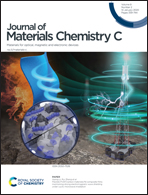Investigation of ferrimagnetism and ferroelectricity in AlxFe2−xO3 thin films†
Abstract
AlxFe2−xO3 (x-AFO) thin films, belonging to the κ-Al2O3 family, are interesting because they show room temperature ferrimagnetism and have a polar crystal structure. These types of materials are being studied to observe simultaneous ferrimagnetism and ferroelectricity, and the possibility of coupling between the two. However, it is difficult to realise ferroelectric properties at room temperature, due to the low resistivity of the films. In this work, we have optimized the synthesis conditions to obtain x-AFO (0.5 ≤ x ≤ 1) thin films with high resistance. While magnetic measurements confirmed room temperature ferrimagnetism of the films, the maximum magnetization was observed for the composition x = 0.8. In addition, the Curie temperature was found to be influenced by oxygen pressure during deposition. Ferroelectric measurements on the films showed small remnant polarization (∼0.5–2 μC cm−2). In contrast, the predicted polarization from first principles calculations was calculated to be between 21 and 26 μC cm−2. The analysis also suggested that ferroelectric domain-switching occurs through shearing of in-plane oxygen layers. The presence of multiple in-plane domains, which oppose polarization switching of adjacent domains, is suggested to be the cause of the small observed polarization. The magnetocapacitance measurements showed weak magnetic coupling with the capacitance.



 Please wait while we load your content...
Please wait while we load your content...